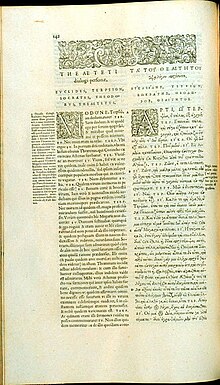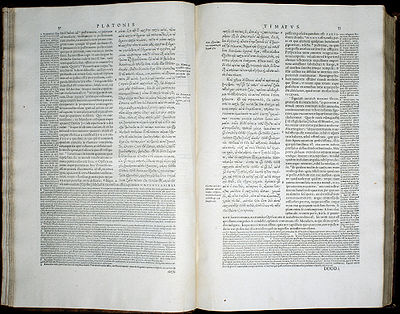
Marsilio Ficino was an Italian scholar and Catholic priest who was one of the most influential humanist philosophers of the early Italian Renaissance. He was an astrologer, a reviver of Neoplatonism in touch with the major academics of his day, and the first translator of Plato's complete extant works into Latin. His Florentine Academy, an attempt to revive Plato's Academy, influenced the direction and tenor of the Italian Renaissance and the development of European philosophy.

Plato was an ancient Greek philosopher born in Athens during the Classical period.
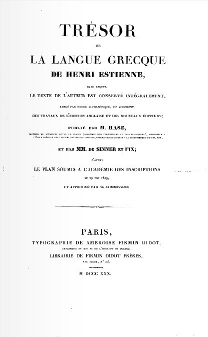
Henri Estienne, also known as Henricus Stephanus, was a French printer and classical scholar. He was the eldest son of Robert Estienne. He was instructed in Latin, Greek, and Hebrew by his father and would eventually take over the Estienne printing firm which his father owned in 1559 when his father died. His most well-known work was the Thesaurus graecae linguae, which was printed in five volumes. The basis of Greek lexicology, no thesaurus would rival that of Estienne's for three hundred years.
There are many different numbering schemes for assigning nominal numbers to entities. These generally require an agreed set of rules, or a central coordinator. The schemes can be considered to be examples of a primary key of a database management system table, whose table definitions require a database design.
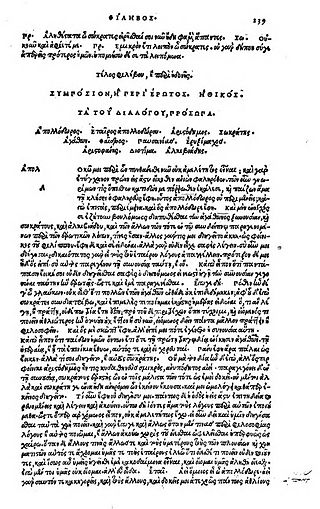
The Symposium is a philosophical text by Plato, dated c. 385–370 BC. It depicts a friendly contest of extemporaneous speeches given by a group of notable men attending a banquet. The men include the philosopher Socrates, the general and political figure Alcibiades, and the comic playwright Aristophanes. The speeches are to be given in praise of Eros, the god of love and desire.

Thomas Taylor was an English translator and Neoplatonist, the first to translate into English the complete works of Aristotle and of Plato, as well as the Orphic fragments.
The Laws is Plato's last and longest dialogue. The conversation depicted in the work's twelve books begins with the question of who is given the credit for establishing a civilization's laws. Its musings on the ethics of government and law have established it as a classic of political philosophy alongside Plato's more widely read Republic.

The Works of Aristotle, sometimes referred to by modern scholars as the Corpus Aristotelicum, is the collection of Aristotle's works that have survived from antiquity.
Hippias Major, is one of the dialogues of Plato, although its authenticity has been doubted. It belongs to the early dialogues, written while the author was still young. Its precise date is uncertain, although a date of c. 390 BC has been suggested.
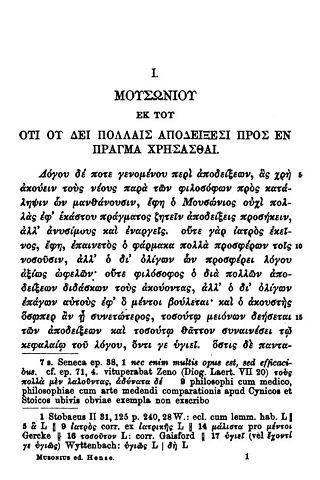
A critical apparatus in textual criticism of primary source material, is an organized system of notations to represent, in a single text, the complex history of that text in a concise form useful to diligent readers and scholars. The apparatus typically includes footnotes, standardized abbreviations for the source manuscripts, and symbols for denoting recurring problems.
The Epistles of Plato are a series of thirteen letters traditionally included in the Platonic corpus. With the exception of the Seventh Letter, they are generally considered to be forgeries, although many scholars even reject the seventh.They were "generally accepted as genuine until modern times"; but by the close of the nineteenth century, many philologists believed that none of the letters were actually written by Plato.

The Lovers is a Socratic dialogue included in the traditional corpus of Plato's works, though its authenticity has been doubted.
Philipof Opus was a philosopher, astronomer, and mathematician. He was a member of Plato’s Academy and after the master's death, edited his last work, Laws. He is generally considered the author of the Platonic Epinomis, a follow-on conversation among the same interlocutors.
This page is a list of topics in ancient philosophy.

Theatrum Chemicum is a compendium of early alchemical writings published in six volumes over the course of six decades. The first three volumes were published in 1602, while the final sixth volume was published in its entirety in 1661. Theatrum Chemicum remains the most comprehensive collective work on the subject of alchemy ever published in the Western world.

The Definitions is a dictionary of 184 philosophical terms sometimes included in the corpus of Plato's works. Plato is generally not regarded as the editor of all of Definitions. Some ancient scholars attributed Definitions to Speusippus.

Bekker numbering or Bekker pagination is the standard form of citation to the works of Aristotle. It is based on the page numbers used in the Prussian Academy of Sciences edition of the complete works of Aristotle (1831–1837) and takes its name from the editor of that edition, the classical philologist August Immanuel Bekker (1785–1871); because the Academy was located in Berlin, Germany, the system is occasionally referred to by the alternative name Berlin numbering or Berlin pagination.

Diels–Kranz (DK) numbering is the standard system for referencing the works of the ancient Greek pre-Socratic philosophers, based on the collection of quotations from and reports of their work, Die Fragmente der Vorsokratiker, by Hermann Alexander Diels. The Fragmente was first published in 1903, was later revised and expanded three times by Diels, and was finally revised in a fifth edition (1934–7) by Walther Kranz and again in a sixth edition (1952). In Diels–Kranz, each passage, or item, is assigned a number which is used to uniquely identify the ancient personality with which it is concerned, and the type of item given. Diels–Kranz is used in academia to cite pre-Socratic philosophers, and the system also encompasses Sophists and pre-Homeric poets such as Orpheus.
Jean de Serres was a major French historian and an advisor to King Henry IV during the Wars of Religion that marred the French Reformation in the second half of the Sixteenth Century. As a refugee from religious persecution, he was educated in Switzerland and became a Calvinist pastor, humanist, poet, polemicist, and diplomat. His complete translation of Plato appeared in the famous 1578 edition published by Henri Estienne, which is the source of the standard 'Stephanus numbers' still used by scholars to refer to Plato's works. In 1596, de Serres was appointed 'Historian of France' by King Henry IV. His posthumously published History of France was an 'immense success' and was not superseded for almost a century.
Robert Gregg Bury was an Irish clergyman, classicist, philologist, and a translator of the works of Plato and Sextus Empiricus into English.
